|
|
|
Sort Order |
|
|
|
Items / Page
|
|
|
|
|
|
|
| Srl | Item |
| 1 |
ID:
142783
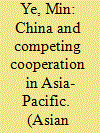

|
|
|
|
|
| Summary/Abstract |
A big question looming large over policy and theory in Asian security is how China will use its newfound wealth and power in the region and with what consequences. The United States has concluded the negotiation of Trans-Pacific Partnership (TPP); ASEAN has promoted the Regional Comprehensive Economic Partnership (RCEP). Both frameworks seek to shape China’s regional behavior and manage rising China. In late 2013, China inaugurated the new Silk Road initiative, which has rapidly gained momentum in the country and among China’s neighbors. American public and policy makers, however, are largely unaware or baffled by the new Silk Road. The article, based on field surveys and extensive documentary analysis, provides the first roadmap on how China views TPP, RCEP, and the new Silk Road. It offers important exploration of how China acts and reacts to regional contestation and what are implications for the region.
|
|
|
|
|
|
|
|
|
|
|
|
|
|
|
|
| 2 |
ID:
147106
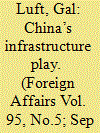

|
|
|
|
|
| Summary/Abstract |
Over the past three millennia, China has made three attempts to project its economic power westward. The first began in the second century BC, during the Han dynasty, when China’s imperial rulers developed the ancient Silk Road to trade with the far-off residents of Central Asia and the Mediterranean basin; the fall of the Mongol empire and the rise of European maritime trading eventually rendered that route obsolete. In the fifteenth century AD, the maritime expeditions of Admiral Zheng He [1] connected Ming-dynasty China [2] to the littoral states of the Indian Ocean. But China’s rulers recalled Zheng’s fleet less than three decades after it set out, and for the rest of imperial history, they devoted most of their attention to China’s neighbors to the east and south.
|
|
|
|
|
|
|
|
|
|
|
|
|
|
|
|
| 3 |
ID:
147977
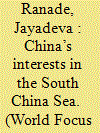

|
|
|
|
|
| Summary/Abstract |
Dominance of the South China Sea is not merely a territorial issue for China but, more importantly, one which it regards as a major step towards recognition as an unrivalled Asia-Pacific power that can arbitrate on global and regional issues along with the US. Since the 18th Congress of the Chinese Communist Party (CCP) and appointment of Xi Jinping simultaneously to China’s three top posts in November 2012, the world is witness to a new thrust to China’s already assertive foreign policy. Early in Xi Jinping’s term, China launched major, bold, geo-strategic initiatives aimed at expanding China’s diplomatic and economic influence and military power well beyond its frontiers.
|
|
|
|
|
|
|
|
|
|
|
|
|
|
|
|
| 4 |
ID:
147975
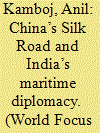

|
|
|
|
|
| Summary/Abstract |
The OBOR strategy has become China’s major foreign policy goal, Beijing will promote this initiative economically, politically, militarily and culturally over the next eight to ten years. For India, there are lessons from this. New Delhi also benefits from at least reasonable ties with most stakeholders in the New Silk Road, including Iran, where India has invested heavily in the Chabahar Port. But India must also make serious efforts to strengthen its links with Southeast Asia, and for this it must maintain stronger ties with Bangladesh. New Delhi will also need to work towards a manageable relationship with Pakistan, which would not only facilitate pipeline projects like TAPI, but also enable access to Afghanistan and Central Asia.
|
|
|
|
|
|
|
|
|
|
|
|
|
|
|
|
| 5 |
ID:
157660
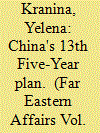

|
|
|
|
|
| Summary/Abstract |
China has adopted a policy for fundamentally solving ecological problems that emphasizes ensuring a balance between economic development and preserving the environment, reforming the legal system in the field of ecology, and introducing green technologies during the mass movement of industry from the eastern part of the country to the west, combined with caring for the environment of the territories they occupy.
|
|
|
|
|
|
|
|
|
|
|
|
|
|
|
|
| 6 |
ID:
142357
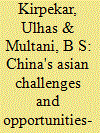

|
|
|
| 7 |
ID:
157115


|
|
|
|
|
| Publication |
London, Zed Books, 2017.
|
| Description |
xii, 292p.pbk
|
| Standard Number |
9781783609239
|
|
|
|
|
|
|
|
|
|
|
|
Copies: C:1/I:0,R:0,Q:0
Circulation
| Accession# | Call# | Current Location | Status | Policy | Location |
| 059277 | 327.51/MIL 059277 | Main | On Shelf | General | |
|
|
|
|
| 8 |
ID:
100614
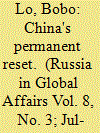

|
|
|
| 9 |
ID:
163413


|
|
|
| 10 |
ID:
141939


|
|
|
|
|
| Summary/Abstract |
BY THE EARLY TWENTY-FIRST CENTURY, the United States and China found themselves strategically and economically interconnected at the global level with elements of military-political rivalry. Chinese diplomacy carefully avoided direct confrontation with America on the world arena,1 that probably meant that Beijing was biding its time to multiply its political might (very much in line with Deng Xiaoping's taoguang yanghui tactics - "conceal our capabilities, avoid the limelight"). Much of what China is doing - building up its military budget, undertaking military modernization, seeking access to natural resources outside its territory, etc. - was interpreted as a movement in this direction.
|
|
|
|
|
|
|
|
|
|
|
|
|
|
|
|
| 11 |
ID:
152542
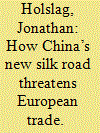

|
|
|
|
|
| Summary/Abstract |
For all the promises of mutually beneficial cooperation, Chinese policy documents about the New Silk Road, also called ‘One Belt, One Road’, mostly testify to a strong ambition to unlock foreign markets and support domestic firms in taking on foreign competitors. This confirms China’s shift from defensive mercantilism, which aims to protect the home market, towards offensive mercantilism, which seeks to gain market shares abroad. In a context of global economic stagnation, this comes as a major challenge to Europe. As China’s market share grows spectacularly in countries along the New Silk Road, key European member states have both lost market shares and even seen their exports shrink in absolute terms.
|
|
|
|
|
|
|
|
|
|
|
|
|
|
|
|
| 12 |
ID:
160483
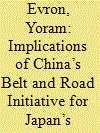

|
|
|
|
|
| Summary/Abstract |
In recent years, the ties between Asian powers and Middle Eastern countries have grown significantly, and the consequence of this development is a gradual spin-off of intra-Asian political process to the Middle East. China’s Belt and Road Initiative (BRI) provides an intriguing illustration of such a possible spin-off. Japan’s response to BRI is mostly negative but less clear is the possible implications of the China–Japan confrontation over BRI for their interaction with the Middle East. Japan’s responses to the BRI and China’s perceptions thereof can expand the set of factors that shape the two Asian powers’ involvement in that region.
|
|
|
|
|
|
|
|
|
|
|
|
|
|
|
|
| 13 |
ID:
147986
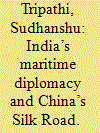

|
|
|
|
|
| Summary/Abstract |
India, while clinching on its rechristened Look East Policy, must act towards evolving a regional bonding of greater Asia as a regional bulwark against the backdrop of mounting tensions in the Indo-Pacific region due to rising Chinese expansionist assertions based on bullying tactics of its awesome military power, accompanied by economic allurements under its silk road initiative in Central Asia and string of pearls scheme in littoral regions of Indian Ocean and adjoining areas with ultimate purpose of establishing its hegemony all over the world. In this scenario, India needs to strengthen its strategic relations with all the littoral countries around its maritime zone and beyond to include all Southeast Asian nations, Persian-gulf, West Asia and African continent so as to strengthen and consolidate its maritime diplomacy and consequent naval strategy.
|
|
|
|
|
|
|
|
|
|
|
|
|
|
|
|
| 14 |
ID:
147981


|
|
|
|
|
| Summary/Abstract |
As India China turn their gaze seaward in search of prosperity and energy security, both have embarked on a naval build up unprecedented in the nation’s modern history. Both countries in earlier centuries participated in mercantile trade and had their association with Southeast and South Asian nations. Indian leadership and strategic experts have been trying to revive the grand old strategy of ‘Indian Ocean being regarded as British lake/Indian lake’, therefore commanding the entire region as maritime power. China’s contemporary leadership also sees their rise as economic, military, and naval power as merely the latest phase in a benign regional dominance that had its origins in the Ming era. India and China, both today are busy in their naval build-up and fierce diplomatic manoeuvres and are trying to prevail upon their neighbours/coastal nations not to align with external powers to balance them.
|
|
|
|
|
|
|
|
|
|
|
|
|
|
|
|
| 15 |
ID:
153453


|
|
|
|
|
| Summary/Abstract |
The author analyzes the book by the Chinese historian Li Weili entitled I. Bichurin, the Guru of Russian Sinology and notes its timeliness and importance within the framework of the modern development trend of Russo-Chinese relations and the New Silk Road Economic Belt project. On the basis of newly found documents, the author gives more accurate biographical information about I. Bichurin (1777-1853), his birthplace, his father, etc.
|
|
|
|
|
|
|
|
|
|
|
|
|
|
|
|
| 16 |
ID:
114348


|
|
|
|
|
| Publication |
2012.
|
| Summary/Abstract |
This commentary will begin by giving a background of the 'New Silk Road' and its different versions, moving on to a discussion of the geopolitical and economic factors related to it. The commentary will then try to analyse some of the critical obstacles to the 'New Silk Road' and also make recommendations for a more acceptable and feasible project within the current geopolitical set-up.
|
|
|
|
|
|
|
|
|
|
|
|
|
|
|
|
| 17 |
ID:
151719
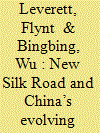

|
|
|
|
|
| Summary/Abstract |
The “new Silk Road” has emerged as the signature foreign policy initiative of Xi Jinping’s presidency and the main channel through which China is adapting its grand strategy to address daunting economic, environmental, and strategic challenges. In elite discourse, China’s “period of strategic opportunity” (zhànlüè jī yùqī 战略机遇期) is no longer defined mainly by other powers’ relatively benign postures. In this context, the new Silk Road offers unique insight into descriptions of Chinese foreign policy as becoming more fènfā yǒu wéi 奋发有为 (proactive, or self-achieving): China can increasingly leverage its own capabilities to enhance Chinese influence and secure Chinese interests by proactively encouraging greater regional and global multipolarity. While the West has long-term interests that would be well served by the new Silk Road’s success, this would also appreciably augment China’s strategic autonomy, ultimately compelling substantial adaptation in American grand strategy.
|
|
|
|
|
|
|
|
|
|
|
|
|
|
|
|
| 18 |
ID:
125108


|
|
|
|
|
| Publication |
2013.
|
| Summary/Abstract |
RECENTLY, the United States has been demonstrating much more activity and much more interest in Central Asia. When analyzing what was said and is said about this region in the United States we should bear in mind that the country had no school of Central Asian studies, the subject being discussed by Orientalists, former Sovietologists and political scientists at large. Each defended his own approach which made American regional politics highly specific, prone to excesses and, therefore, highly varied and inclined to go to extreme (up to and including politically incorrect) variants.
|
|
|
|
|
|
|
|
|
|
|
|
|
|
|
|
| 19 |
ID:
160949
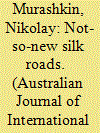

|
|
|
|
|
| Summary/Abstract |
Scholarly narratives concerning China's Belt and Road Initiative (BRI) tend to contextualise this project within China's rivalry with the United States and Japan. Such interpretations often reduce and misconstrue Japan's initiatives in Asian infrastructure finance as mere reactivity to China's advances. This paper will showcase Japan's own foreign and financial policies regarding infrastructure in Asia and the New Silk Road regions since the end of the Cold War. I argue that Japan's presence in that field is underappreciated and under-researched, as Japan's infrastructural footprint in the New Silk Road significantly pre-dates the BRI. Furthermore, I stress the fact that Japan's foreign policy in Asian infrastructure finance featured important cooperative postures toward China, especially within multilateral development banks. The paper makes a contribution to emerging scholarship on the BRI—often reliant on strategic communications and projections—by highlighting Japan's role in regional infrastructure to show how our understanding of international relations and international political economy in Asia can be better informed by economic history and area studies.
|
|
|
|
|
|
|
|
|
|
|
|
|
|
|
|
| 20 |
ID:
137227
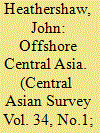

|
|
|
|
|
| Summary/Abstract |
For the first two decades of independence, most academics and policy analysts viewed Central Asia as detached from the global economy and immune to the diffusion of globalization trends. The apparent failure of ‘transition’ – allegedly manifest in high levels of corruption, elite control of critical industries and assets, and low levels of formal intra-regional trade – has been interpreted as further evidence of Central Asia's distance from the world economy and has led to new initiatives to bridge the gap. This is most evident in US State Department's recent vision of creating a New Silk Road that would increase trade and infrastructure linkages between Afghanistan and the Central Asian states.
|
|
|
|
|
|
|
|
|
|
|
|
|
|
|
|
|
|
|
|
|